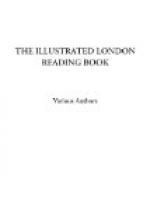The Bushman retains the ancient arms of the Hottentot race, namely, a javelin or assagai, similar to that of the Caffres, and a bow and arrows. The latter, which are his principal weapons both for war and the chase, are small in size and formed of slight materials; but, owing to the deadly poison with which the arrows are imbued, and the dexterity with which they are launched, they are missiles truly formidable. One of these arrows, formed merely of a piece of slender reed tipped with bone or iron, is sufficient to destroy the most powerful animal. But, although the colonists very much dread the effects of the Bushman’s arrow, they know how to elude its range; and it is after all but a very unequal match for the fire-lock, as the persecuted natives by sad experience have found. The arrows are usually kept in a quiver, formed of the hollow stalk of a species of aloe, and slung over the shoulder; but a few, for immediate use, are often stuck in a band round the head.
A group of Bosjesmans, comprising two men, two women, and a child, were recently brought to this country and exhibited at the Egyptian Hall, in Piccadilly. The women wore mantles and conical caps of hide, and gold ornaments in their ears. The men also wore a sort of skin cloak, which hung down to their knees, over a close tunic: the legs and feet were bare in both. Their sheep-skin mantles, sewed together with threads of sinew, and rendered soft and pliable by friction, sufficed for a garment by day and a blanket by night. These Bosjesmans exhibited a variety of the customs of their native country. Their whoops were sometimes so loud as to be startling, and they occasionally seemed to consider the attention of the spectators as an affront.
[Illustration: BUSHMEN.]
* * * * *
CHARACTER OF ALFRED, KING OF ENGLAND.
The merit of this Prince, both in private and public life, may with advantage be set in opposition to that of any Monarch or citizen which the annals of any age or any nation can present to us. He seems, indeed, to be the realisation of that perfect character, which, under the denomination of a sage or wise man, the philosophers have been fond of delineating, rather as a fiction of their imagination than in hopes of ever seeing it reduced to practice; so happily were all his virtues tempered together, so justly were they blended, and so powerfully did each prevent the other from exceeding its proper bounds. He knew how to conciliate the most enterprising spirit with the coolest moderation; the most obstinate perseverance with the easiest flexibility; the most severe justice with the greatest lenity; the greatest rigour in command with the greatest affability of deportment; the highest capacity and inclination for science, with the most shining: talents for action. His civil and his military virtues are almost equally the objects of our admiration, excepting only, that the former,




